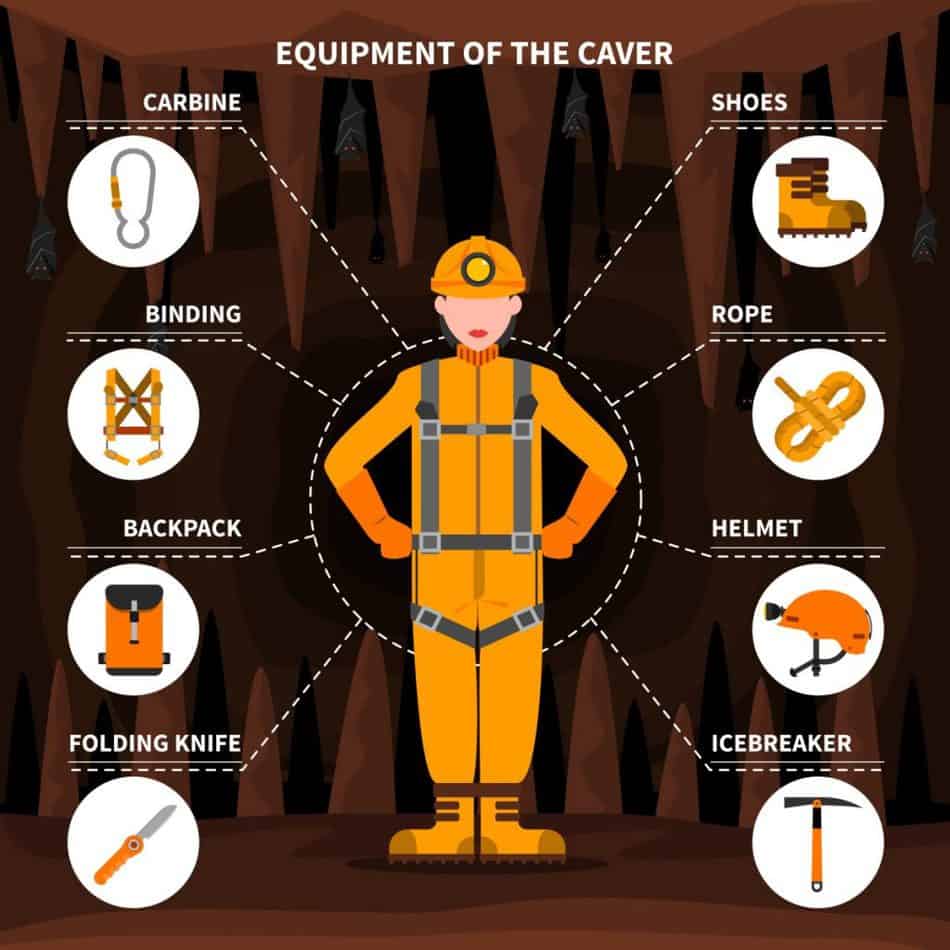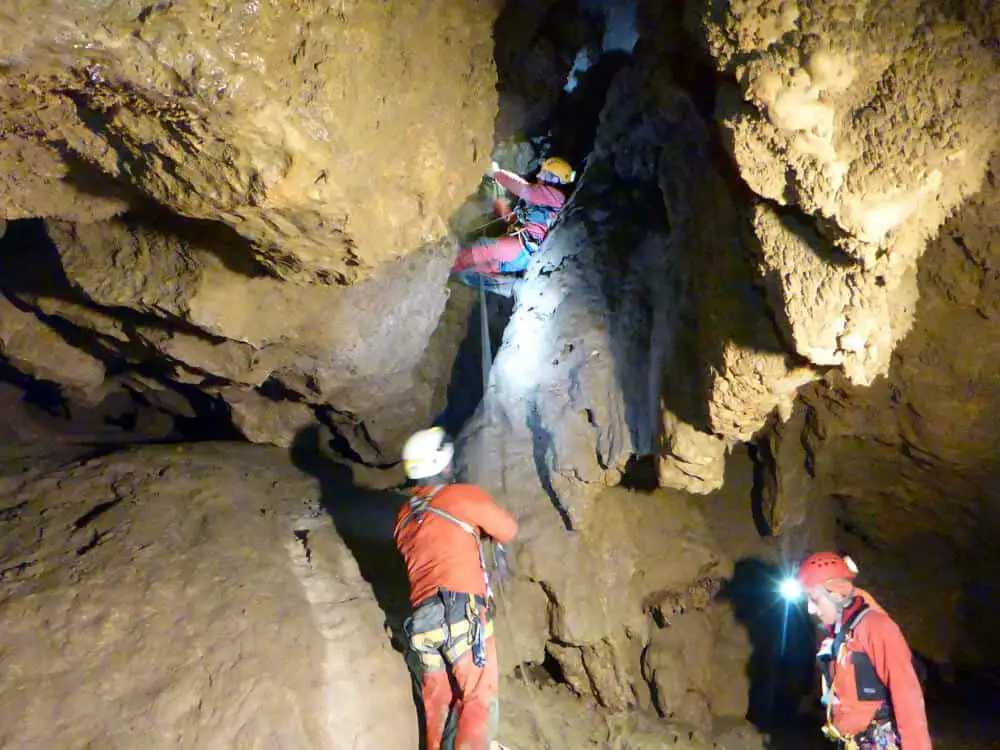The first question many people ask me when I say I’m a caver: “isn’t that dangerous?” I’ve never particularly felt at risk, but I guess it depends on how responsible you are, and how well you’re prepared. So is it – dangerous? In this article, I talk facts, not opinions.
Is caving dangerous? Caving can be dangerous: you run the risk of hypothermia, rockfall, drowning, exhaustion, and bad air. But with the proper preparation and gear, you can greatly offset the risk. Statistically, high-risk cavers run a 1 in 3,332 chance of dying. Roughly 1 in 624 cavers get seriously injured.
In fact, fewer people get hurt in caving than in traffic. The number one threat to cavers is unpreparedness.
How dangerous are cave tours? If you’re going on a guided caving trip, don’t worry: guided tours tend to be very safe. Statistically, cave tour visitors run almost no risk. Just follow the instructions of the trip leader and enjoy the experience. The caves are professionally maintained. Geologists do regular risk assessments and the air quality will be good. You’ll be fine.
If you’re going in for the first time, be sure to read our safety tips for first time cavers at the bottom of this post. Educate yourself: don’t go unprepared.
If you’re ready to get started caving, be sure to read my Beginners Guide and check out my recommended gear section.
In this article:
- How Many Cavers Die Each Year?
- What Makes Caving Dangerous?
- But What If I Get Lost?
- Risks of Caving
- Safety Tips
- Tips for First Timers
How Many Cavers Die Each Year?
- Roughly 3 people die each year in caving accidents in the US
- Roughly 1,5 people die each year in caving accidents in the UK
- On average 16 people get seriously injured each year in the US
In the UK, 132 people have died from caving accidents over the last 90 years.
In the US, 24 people are reported to have died in caving accidents in the last decade (source: NSS American Caving Accidents on File).
In a 2008 study, a number of doctors studied the number of caving deaths in the US over a 28 year period (1980 – 2008) (link to abstract of study). In this period, 81 cavers died. On average, three cavers died each year in the US between 1980 and 2008.
In the same period 446 traumatic injuries were reported. This gives us an average of 16 serious injuries each year.
The estimated number of people who visit caves annually is about 2,000,000 in the US alone.
- 1 in 666,666 of all people visiting caves actually die
- 1 in 125,000 get seriously injured
In percentages, this is a 0.0000015% chance of dying and a 0.000008% chance of getting badly injured.
Of those 2 million, about 10,000 are a member of the National Speleological Society. It’s a safe bet to say these folks do the high-risk cave exploring. Let’s assume only high-risk cavers are involved in caving accidents. What are the odds of dying or getting hurt?
- 1 in 3,332 of all high-risk cavers die
- 1 in 624 get seriously injured
Most accidents occur among unprepared and untrained cavers that do high-risk exploring. In contrast, experienced cavers are very aware of the dangers involved and take action to mitigate the risks. The right kind of skills and training can greatly reduce the dangers of caving.
Cavers risk of dying compared to 10 other sports:
But even if we use these (very conservative) numbers to compare caving to ten other high-risk sports, it holds up pretty well. Your chances of dying as a climber are roughly double.
| Sport | Odds of dying |
|---|---|
| Base jumping | 1 in 60 |
| Grand Prix racing | 1 in 100 |
| Hang gliding | 1 in 560 |
| Motorbike Racing | 1 in 1,000 |
| Mountain climbing | 1 in 1,750 |
| Boxing | 1 in 2,200 |
| Caving | 1 in 3,332 |
| Canoeing | 1 in 10,000 |
| Skydiving | 1 in 101,083 |
| Bicycling | 1 in 140,845 |
| Bungee jumping | 1 in 500,000 |
What Makes Caving Dangerous?
The leading causes of death among cavers are falls and drowning, both accounting for nearly half of all caving deaths. In the US, falls are the number one cause of death (42%).
The main problem with caving accidents is that when something does happen, the person is difficult to reach. So a small error of judgment can become a huge problem later on (ie. you overestimate your own capabilities or underestimate the conditions). Most caving accidents are due to bad preparation, lack of skill, or the wrong equipment.
According to Stella-Watts, who’s researched caving accidents, it’s simple:
“Being properly dressed to protect from the wet environment, good footwear, and most of all good headlamps can make a dramatic improvement in the condition of cavers,”
If you set out to be a sensible caver – educate yourself, keep the best practice in mind, and prepare yourself properly – there’s actually not much to worry about. But you should be aware of your skill level, the limits of your equipment, and the demands of your environment.
But What If I Get Lost?
Most new cavers are afraid to get lost, but it’s very uncommon. And of the people that do get lost, most only wander around for (or get pulled out by rescuers within) a couple of hours. Rarely ever do people die of getting lost in a cave. Over the last 90 years, in the UK just 12 people died from Hypothermia or getting lost (2). Those numbers are really comforting.
If you want to know what to do in case it happens, after all, you might want to read my article on how to escape a cave.
Risks of Caving Involve:
- Falling rocks
- Caver’s fall – the leading cause of death among cavers
- Flooding – drowning, as a result, is a leading cause of death among cavers
- Running out of light – always bring at least three independent light sources + spare batteries
- Physical exhaustion
- Getting lost or stuck – not very common
- Cave-ins
- Claustrophobia
- Hypothermia
- Dehydration – caving is an extreme sport, so be sure to drink plenty of water
- Bad air
- Cave disease (Histoplasmosis)
- Leptospirosis (link to Wikipedia)
Falling rocks
Most caves are extremely stable. However, cavers have to pay close attention to any loose rocks. Rockfall is a common cause of death among cavers. Even a tiny rock can cause severe injury if it travels far enough before impact.
Wear your helmet at all times – do not take it off.
Especially when entering wild (unsurveyed – we also call these virgin) caves, as these are more likely to have some loose debris. If you suspect some rocks are unstable, be sure not to dislodge them. Most lethal accidents involve rockfall while the caver was descending or ascending – and the rocks were dislodged by their own gear.
Caver’s fall
Falling and slipping due to poor footing is a major cause of fatalities. Caves can be quite treacherous and slippery. Make sure you have enough points of contact. Also, be sure to wear the right kind of shoes. Generally, you can simply wear all-rubber wellies. They will do just fine. If you want to know more about picking the right shoes, read my buyer’s guide on wellies.
Flooding
Don’t go caving when it rains, especially with heavy rainfall. Drowning is among the leading causes of death.
Most caves are formed by rainwater corroding the limestone while it travels underground. So flooding is one of the most common hazards, and it’s a serious danger. Getting trapped in a cave by flooding can lead to death by drowning or even suffocation. To make sure the cave isn’t prone to flooding, check for the following:
- Flood debris around a cave entrance indicates prior flooding
- Leafs and debris that are stuck to the ceiling – the cave has flooded in the recent past
If you find yourself in a flooded cave, go to the highest point possible and protect yourself against hypothermia.
Bad air
Bad air means the air in the cave is contaminated in any way. This might mean low oxygen levels, increased carbon dioxide levels, ammonia, and so on. Bad air only occurs in about 1% of caves, making it a less common hazard, but very serious nonetheless. Particularly caves in the UK seem to have some bad air.
Low oxygen can be a danger in small pockets and holes. You use up any oxygen and breathe out CO2, which means that if there’s bad airflow, you might potentially use up your oxygen stash. This is a very rare situation, as most caves have good air circulation. Try not to stay in depressions and small pockets too long, though, just to be safe.
A candle or carbide headlamp won’t protect you from hypoxia (oxygen deficiency): they both burn with lower amounts of oxygen than is healthy for the human body (15%). At this percentage, the body suffers from serious hypoxia.
- Carbon dioxide tends to build up in some caves because it’s heavier than oxygen.
- Old mines are notorious for bad air, so beware of what type of cave you’re entering beforehand.
Cave disease (Histoplasmosis)
Also called caver’s disease or spelunker’s lung, this is a fungus infection, caused by the Histoplasma capsulatum.
The fungus is mostly found in soil with bat guano or bird droppings. You can pick up this fungus by disrupting the soil. It’s most prevalent in warm, dry climates. For more details on the disease, please visit Wikipedia.
Safety Tips – How to Reduce Caving Risks?
- Join your local grotto: they often provide free training and safety information
- Don’t exceed your limits
- Wear a helmet at all times
- Use the right gear, and make sure it’s proper
- Check for the danger of flooding – if it’s raining, don’t go
- Never go in alone
- Get a permit or permission – speaking to the owner or manager will get you crucial information on the area and the cave.
- Let someone know you’re in there and how late they can expect you to get home
- Carry a cave map
- Carry extra lights
- Watch out for CO2 – if you’re dizzy, light-headed, get a headache, nausea, shortness of breath: leave the cave immediately
Know your skills and limitations
Only use ropes if you’re properly trained – vertical caving requires special skill, equipment, and experience. It’s not the same as rock climbing: the techniques and gear vastly differ. Do not attempt to do rope work before getting training from a reliable instructor. Check out the NSS Vertical Section for more information.
Only dive in caves if you’re properly trained – cave diving is the most expert caving technique, and should only be attempted by trained and licensed cave divers. Having a scuba license does not in the least qualify you for cave diving, since the techniques, conditions, and equipment greatly differ. Please do not attempt any form of cave diving before being properly trained. Check out the NSS Cave Diving Section for more information.
Make sure your gear is proper
Reliable gear is key in challenging conditions. So make sure it’s reliable. You should check up on your gear before every caving trip, no exceptions.
- Is your helmet solid? – Once it has taken an impact, you should replace it. Helmets can’t take more than a couple of good impacts before cracking wide open. You don’t want that.
- Is your overall still in one piece?
- Are your pads and gloves still decent?
- Are your navigation tools functioning properly?
- Are your lights working and do you have working backup batteries?
Pack the right stuff. Check out our equipment packing list here to make sure you have everything at hand.
The rule of three
The rule of three dictates you:
- only enter the cave with at least three people,
- each takes three independent sources of light,
- each takes three pairs of spare batteries with you.
Safety Tips for First Time Cavers
If you’re going in for the first time, please remember the next simple rules to stay safe:
- Don’t exceed your limits – if you’re feeling exhausted, uncomfortable, claustrophobic, or anything of the things we’ve discussed: let others know. Don’t keep secrets in this environment. If you feel drained of energy, make sure to rest before continuing.
- Go in a group and stay together – the only excuse to split the group up is serious injury or emergency.
- Have an emergency plan – make sure everyone knows what to do in case of an emergency. Appoint a trip leader who will make the decisions in case of crisis. Only act without consulting the trip leader if you’re life’s endangered.
- Keep three points of contact – this rule goes as much for cavers as for climbers. When moving on rough terrain, always keep three points of contact. This will prevent you from slipping and falling, which is a major cause for (serious) injury.
- Take nothing but photos, leave nothing but footprints
Related Questions
Why is cave diving dangerous? The most dangerous aspect of cave diving is human emotion. Cave diving is really stressful. If the diver panics, it might kill him. Other hazards involve getting stuck, drowning, toxic air in passages above the waterline, and technical problems. Due to the ceiling, a cave diver can’t surface in case of emergency.

When you’re ready to get started caving, be sure to read my Beginners Guide and check out my recommended gear section.

